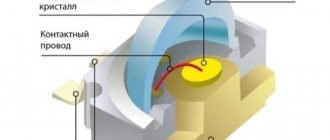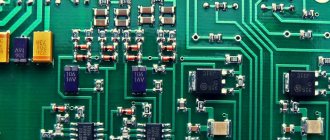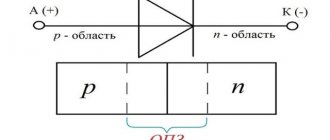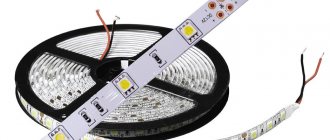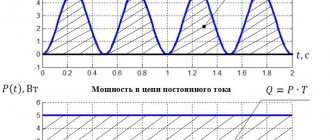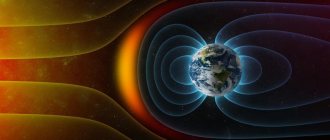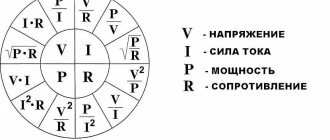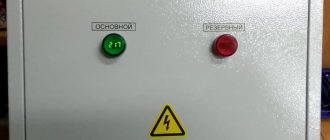Types and main parameters of LEDs
In the diagram, the LED is indicated as a regular diode with two parallel arrows pointing outward, indicating its emitting nature. There are a large number of types of LEDs on sale, which differ in functionality, design, power, glow color and other properties.
Based on their purpose, LEDs are divided into two types - indicator and lighting.
Indicative:
- SMD LEDs;
- super bright Super Flux “Piranha”;
- DIP LEDs (Direct In-line Package);
- Straw Hat (“straw hat”).
Lighting:
- COB (Chip On Board) LEDs;
- SMD LED;
- filament (Filament LED).
Indicative
Indicator LEDs are characterized by low power and moderate brightness. They are used for color indication of operating modes of various devices and equipment, as well as for illumination of displays and instrument panels. Types of indicator LEDs:
- DIP LEDs. The emitter crystal is located in an output housing, which most often is a convex lens. The downside is the small radiation scattering angle.
- “Piranha” is an ultra-high brightness emitter with four pins, ensuring its convenient mounting on the board. Demanded for illuminating devices in cars and advertising signs.
- "Straw Hat" A cylindrical two-terminal device with a significant radiation scattering angle and an increased lens diameter. Used in decorative structures and alarm lights.
- SMD LEDs. Ultra-high brightness devices are housed in housings designed for SMT mounting. Their markings indicate dimensions in inches (hundredths thereof) or in mm. LED strips are manufactured based on SMD LEDs.
Lighting
Lighting LEDs are found in the design of lanterns, headlights, and strips. They differ in the power and brightness of the glow. Most lighting fixtures are housed in SMT mounting housings. Available in two varieties of white:
- cool white – cold;
- warm white – warm.
An SMD lighting LED is a heat-sinking substrate on which a emitting crystal treated with a phosphor composition is mounted.
Operating principle and design of light diodes
A diode that emits light consists of a substrate and a crystal. The substrate can be of any shape, the most common being square. A reflector and lens are applied to the body. The crystal is placed on the reflector. Light is emitted when an electric current passes through the pn junction of the crystal.
To connect to the network, there are two (or more) pins (anodes and cathodes), some of which are connected to the crystal. The lens is most often made of a transparent polymer; its main purpose is to determine the direction of the beam and the scattering angle.
The reason for the glow of the crystal is the recombination of electrons and holes at the pn junction formed by two semiconductors with different conductivities. The movement of particles is ensured by impurities (donors and acceptors). It is important that the crystal does not have any defects that would prevent it from emitting a visible light beam. To ensure such characteristics in practice, the crystal is made multilayer.
To get a white glow, you need to:
- mix colors using RGB technology;
- apply a phosphor to the ultraviolet-emitting crystal, creating red, green and blue colors;
- Apply green and red phosphor to the blue diode.
Each of these methods has pros and cons. RGB allows you to obtain different color temperatures and change the current passing through the diodes to change the hue. The presence of several crystals in the body makes it possible to increase the strength and flow of light. The disadvantage is that the color is not the same at the edges and in the middle, which leads to overheating and uneven aging.
The use of a phosphor allows you to reduce the cost of LEDs without losing the quality of white color. But the light output is lower, it is difficult to apply the phosphor evenly, so the light temperature is not determined accurately. The main disadvantage is that the phosphor ages faster than the crystal.
Attention! The scope of LEDs depends on the production technology. For the manufacture of lighting devices, diodes with phosphors are mainly used (only RGB strips are made).
By design, LEDs are divided into:
- DIP;
- SMD;
- powerful;
- filamentous;
- COB;
- OLED;
- fiber.
DIP LEDs are needed to make indicator lights. The diameter of the case is 3 or 5 mm; a crystal and a wire connecting it to the anode, and a diffuser are installed in the case. For connection to the network, there are 2 terminals on the case - cathode and anode.
Powerful diodes create an intense luminous flux at a current of up to 1.4 A. The crystal generates a lot of heat, so it is installed on an aluminum radiator, which simultaneously functions as a reflector. To ensure the required level of electric current, a special limiting driver is included in the circuit, which simultaneously stabilizes the voltage.
LED filament lamps are popular among designers due to their external similarity to incandescent lamps. The case is made of ordinary or sapphire glass up to 1.5 mm thick, coated with a phosphor, 28 semiconductors are connected in series and mounted on a substrate. The main advantage is the light dispersion angle of up to 360 degrees.
COB LED (or Chip-On-Board) belongs to the group of the most modern. A large number of crystals are placed on an aluminum (or glass) substrate and coated with a phosphor. COB shines evenly across the entire lens area. These glowing diodes are used in the production of tablets, laptops and televisions. They work the same way as DIPs.
OLED LEDs used in the production of miniature smartphones, tablets, and TVs consist of:
- substrates (plastic, glass, foil);
- polymer layers;
- organic substance that conducts current;
- tin and indium oxide anode;
- aluminum cathode.
Applications of LEDs
Such products are actively used in various fields: illuminated advertising, home and industrial lighting, automotive lighting, traffic lights and road signs, interior design, landscape and architectural lighting, and much more.
Advantages of LEDs:
- significant duration of operation;
- environmental Safety;
- high reliability and reliability;
- energy saving;
- high quality lighting;
- low operating costs.
Advantages of LEDs compared to other light sources
Being qualitatively new sources of electromagnetic radiation, LEDs have a number of significant advantages over their predecessors, which contributes to their widespread permanent implementation in various areas of the national economic complex.
Among the advantages of LEDs, it is necessary to highlight the following qualities and characteristics:
- The absence of mechanically sensitive structural elements in LEDs (such as filament) determines their increased vibration and mechanical resistance to adverse effects during manufacturing, transportation, installation and operation.
- The extremely efficient conversion of electrical energy into light by LEDs determines their extremely high luminous efficiency. Sodium gas-discharge and metal halide lamps, which were the undisputed market leaders in terms of luminous efficiency for many decades, have now lost their leading positions due to the emergence of equally efficient light-emitting diodes. Thus, if the luminous efficiency of sodium gas-discharge lamps is about 150 lm per W of power consumption, then for the most modern LEDs it has reached 146 lm/W and continues to increase with the development of technology and the use of new design solutions.
- The service life of LEDs ranges from 30 thousand to 100 thousand hours, which significantly exceeds the indicators of light sources manufactured using other technologies. The disadvantage of light-emitting diodes is that during long-term operation and/or ineffective heat removal, their crystals are subject to so-called degradation, leading to a gradual decrease in the brightness of the radiation.
- A significant advantage of LEDs is that their service life is independent of the number of on-off iterations. This sets them apart from other light-emitting devices (for example, gas-discharge lamps and incandescent lamps), which are sensitive to the number of on-off cycles.
- The emission of LEDs is inherently spectral purity, while in other devices it is achieved through the use of various light filters.
Spectrographic analysis of red LED emission - The environmental safety of LEDs is due to the fact that their production does not use hazardous elements and compounds (mercury, phosphorus, metal halides). Also, there is no ultraviolet in their radiation spectrum, which leads to the absence of the need to create protection against it.
- LEDs are safe to use because... They are usually powered at relatively low voltages and, due to their high light output, rarely heat up above 50-60 °C
- An important factor contributing to the widespread use of LEDs is the lack of inertia in their switching on: the maximum brightness of the radiation is achieved immediately after switching on, while for energy-saving fluorescent lamps the switching time ranges from 1 second to 1 minute, and reaching 100% brightness occurs within 3- 10 minutes after starting work (depending on the ambient temperature and the characteristics of the lamp).
- The almost zero sensitivity of LEDs to low and ultra-low temperatures allows them to be used outdoors in countries with harsh climates. At the same time, as already noted, LEDs (like any other semiconductor devices) are sensitive to high temperatures. In this regard, when installing LED devices, it is always necessary to pay special attention to the presence of a sufficient level of heat dissipation.
- A wide variation in the emission angle for different types of LEDs (from 15° to 180°) makes it possible to solve various design and technological problems when creating devices using them.
- The presence of a wide range of white LEDs (warm white, daylight white, cool white) makes it possible to use different types to solve various problems, depending on the specific situation and the need to obtain a particular effect from lighting.
- Relatively low cost of LEDs (especially indicator ones).
- High color rendering index CRI.
Basic rules for connecting LEDs
The LEDs are designed to be connected only to direct current sources, maintaining polarity. There are three options for determining polarity:
- According to the length of the leg (except SMD). The longer leg is the cathode, and the shorter leg is the anode. SMD LEDs have a cut (key), which is always located closer to the cathode.
- Using a multimeter. The device is set to the “Dialing” mode. Red and black probes are installed on the terminals. If the device lights up, it means that the red probe was connected to the anode, and the black probe to the cathode. If the glow does not appear, then you need to change the position of the probes. If the result has not changed (there is no light), then the device has failed.
Invention and first samples
Electroluminescence of a silicon carbide crystal (green) was discovered in 1907 by the English scientist Round in Marconi's laboratory.
This phenomenon was not given any significance at the time. In 1923, Soviet scientist O.V. Losev, working at the NRL (Nizhny Novgorod Radio Laboratory), conducted in-depth studies of such a phenomenon as radiative recombination, and also observed the emission of light emanating from crystals of silicon carbide SiC (carborundum). Long-term studies made it possible to formulate the basic principle of electroluminescence of semiconductor structures - injection recombination. In 1927 Losev patented the principle of semiconductor luminescence. The invention was published in Russian, German and English scientific journals, but did not receive practical application. In 1955, R. Brownstein of the Radio Corporation of America announced the presence of infrared radiation from gallium arsenide (GaAs) in combination with other semiconductor alloys. Braunstein observed infrared radiation generated by a simple diode structure based on gallium antimonide (GaSb), gallium arsenide, indium phosphide (InP) and silicon-germanium alloy (SiGe) at room temperature. In 1961, developers R. Bard and G. Pitman, working at Texas Instruments, discovered that gallium arsenide alloy produces infrared radiation when an electric current is passed through it and received a patent for an IR LED.
The first LED emitting light in the visible spectrum was invented in 1962 by N. Holonyak, who worked for General Electric. Since then, many have called him the “father” of modern LEDs. To understand that this is not so, it is enough to study historical information about the research of O.V. Losev and other eminent scientists of 20-50. twentieth century. However, history is unfair, and we have what we have, and in the 60s Russia lost priority in the invention of semiconductor light sources.
In 1972, Holonyak's former student G. Graford invented the yellow LED and increased the brightness of red and red-orange LEDs tenfold. In 1976, T. Pearsall created the first ultra-bright LED for fiber optic telecommunications by inventing new semiconductor alloys specifically adapted to transmit light over fiber optics.
Until 1968, visible and infrared LEDs had a huge cost, about 200 USD per unit, which created difficulties for practical use. But in 1968, Monsanto pioneered the mass production of visible light LEDs based on gallium arsenide phosphide (GaAsP), suitable for use as indicators. Hewlett Paccard, which introduced LEDs in 1968, used Monsanto's LEDs to make digital displays and calculators.
Connection methods
The simplest option is to connect to a low-voltage DC source.
The most convenient and safest option is to connect the LED to a battery or accumulator by including a low-power resistor in the circuit. Its function is to limit the current flowing through the pn junction to a certain value. Without this element, the LED will quickly lose its working properties.
The resistor is selected based on resistance and power. Calculation of resistance using the formula:
R = (Usupply – Upassport.)/Inom., Ohm, in which:
- Usupply – power supply voltage, V;
- Upassport. – voltage drop, rated value, V;
- Inom. - rated current.
The resulting value is rounded up to the nearest nominal value from the E24 series. After this, the power that the resistor must dissipate is calculated.
P = Inom.2 x R, where R is the resistance value selected from the table.
You can carry out all these steps quickly and easily using an online calculator.
Quantum dot LEDs (experimental development)
New LED manufacturing technology developed by M. Bowers involves coating a blue LED with “quantum dots” that begin to emit white light when irradiated with blue light from the LED.
This technology produces a warm yellow-white light similar to incandescent light. “Quantum dots” are semiconductor nanocrystals with unique optical characteristics. Their emission color can be varied over a wide range - from the visible spectrum to the invisible - any color within the CIE diagram. In September 2009, Nanoco Group announced that it had entered into a research agreement with one of the largest Japanese companies. The topic of research is the further development of “quantum dot” technology for use in liquid crystal television displays.
To be continued
Translation, addition and adaptation - Yuri Ruban, led22.ru
How to connect LEDs to a 220 V AC network via a power supply
There are several types of power supplies:
- Stabilized constant voltage sources for 5 Volt and 12 Volt LEDs. When network parameters fluctuate, the voltage at the output of such a power source remains constant and equal to the value stated in the passport. LED lamps are connected through resistors.
- Driver – switching power supply with stabilized current. Characteristics that are taken into account when choosing it: maximum and minimum output voltage, output (operating) current. The driver contains a circuit that stabilizes the current during surges in the 220 V input voltage. When connecting an LED emitter to the driver, a resistor is not required.
Phosphorus LEDs
The spectrum of a white LED is determined by blue light, which is emitted by a GaN-based crystal (peak around 465 Nm) and, passing through yellow phosphorus (500-700 Nm), is converted to white.
The use of different types and shades of phosphorus allows you to obtain different shades of white - from warm to the coldest. The quality of color rendering also depends on this. Applying several layers of different types of phosphorus to the blue crystal allows you to achieve the highest CRI. Phosphorus-based LEDs are less efficient than conventional LEDs because some of the light is scattered in the phosphorus layer, and the phosphorus itself is also subject to degradation. However, this method remains the most popular for commercial production of white LEDs. The most commonly used yellow phosphorus material is Ce3+:YAG.
Also, white LEDs can be made on the basis of ultraviolet LEDs using red and blue phosphorus with the addition of zinc sulfide (ZnS:Cu,Al). This principle is similar to that used in fluorescent lamps. This method is worse than the previous one, but allows you to achieve better color rendition. In addition, ultraviolet diodes have greater luminous efficiency. On the other hand, UV radiation is harmful to humans.
Methods for creating circuits from several LEDs - serial and parallel connection
When connecting several light-emitting devices to a power source, two connection options can be used - serial and parallel.
Sequential
A series connection represents a circuit of semiconductor devices in which the cathode of the first emitter is soldered to the anode of the next one - and so on. A current of the same value flows through all elements of a series circuit, and the voltage drop is summed up. The power of the power supply is selected equal to or greater than the sum of the powers of each element.
Cons of serial connection:
- If there are a significant number of circuit elements, it is necessary to choose a high-voltage power supply.
- If one LED diode fails, the entire circuit stops working.
In long strips with 60-70 diodes on each element there is a voltage drop of approximately 3 V, that is, such strips can be connected to a 220 V network through a rectifier.
Parallel
When connected in parallel, the voltage on all elements of the circuit will be equal, and the currents of each LED will be summed up. The main problem in this case is that LED lamps, even from the same batch, often have different characteristics. Therefore, if you put one common resistor, different current values can be supplied to the light bulbs, as a result of which some elements will shine too brightly, while others will shine dimly. The solution to the problem is to install separate resistors for each diode.
Disadvantages of parallel connection:
- a large number of circuit elements due to the need to use individual resistors for each diode;
- a significant increase in load when one LED diode burns out (if one powerful resistor is used for the entire circuit).
Mixed
This is the most suitable option for connecting LEDs, since it allows you to at least partially compensate for the disadvantages of serial and parallel connections. In this case, chains of sequential elements are connected in parallel. This method is used in modern Christmas tree garlands or ribbons. The advantage of this solution: even if one or more parallel chains fail, the rest will continue to light properly.
Types of LEDs depending on the chemical composition of semiconductors
Since LEDs are semiconductor devices, the materials used to create them are traditional for semiconductor technology. The most common is, of course, gallium in chemical compounds with other elements. Indium, aluminum, and silicon are also widely used.
The use of a variety of compounds makes it possible to obtain LEDs that emit light in the range from infrared to ultraviolet.
And the use of additionally applied phosphors and colored plastics further expands the color palette of the resulting light. Types of semiconductor materials used in LEDs to produce radiation of various spectrums
| Color | Wavelength, nm | Voltage drop, V | Semiconductor materials |
| Infrared | λ > 760 | ΔU | Gallium arsenide (GaAs) Aluminum gallium arsenide (Aluminum gallium arsenide AlGaAs) |
| Red | 610 | 1,63 | Aluminum gallium arsenide (AlGaAs) Gallium arsenide phosphide (GaAsP) Aluminum gallium indium phosphide (AlGaInP) Gallium(III) phosphide (GaP) |
| Orange | 590 | 2,03 | Gallium phosphide arsenide (GaAsP) Aluminum gallium indium phosphide (AlGaInP) Gallium(III) phosphide (GaP) |
| Yellow | 570 | 2,10 | Gallium arsenide phosphide (GaAsP) Aluminum gallium indium phosphide (AlGaInP) Gallium(III) phosphide (GaP) |
| Green | 500 | 1,9 | Indium gallium nitride (InGaN) / Gallium(III) nitride (GaN) Gallium(III) phosphide (GaP) Aluminum gallium indium phosphide (AlGaInP) Aluminum gallium phosphide (AlGaP) |
| Blue | 450 | 2,48 | Zinc selenide (ZnSe) India gallium nitride (InGaN) Silicon carbide (SiC) as substrate Silicon (Si) as substrate - (in development) |
| Violet | 400 | 2,76 | India gallium nitride (InGaN) |
| Purple | Mixture of several spectra | 2,48 | Dual: blue/red diode, blue with red phosphor, or white with purple plastic |
| UV | λ | 3,1 | Diamond (235 nm) Boron nitride (215 nm) Aluminum nitride (AlN) (210 nm) Aluminum gallium nitride (AlGaN) Aluminum gallium indium nitride (AlGaInN) - (less than 210 nm) |
| White | Wide range | ΔU ≈ 3.5 | Blue/violet diode with phosphor |
Lighting indicators
Almost all powerful LED elements operate from a voltage of 12 W, less often from power sources of 24-48 W. You can consider the detailed lighting characteristics using the example of the XLamp XM-L from the Cree brand:
- power – 10 W;
- operating voltage – 12 V;
- energy efficiency indicator – up to 170 lm/V;
- luminous flux – 850 Lm (current 3 A);
- base parameters – 5x5 mm;
- light temperature – from 4000 to 5000 K.
LEDSWith a current of more than 3 A, the light element produces about 910 Lm.
In recent years, we have witnessed the explosive development of another field of technology based on the physics of semiconductors - optoelectronics. First of all, this is manifested in the rapid improvement of LEDs - wonderful semiconductor light sources that are highly likely to transform the world of artificial lighting in the near future. The invention of the transistor, the subsequent creation of the computer and the further rapid development of semiconductor electronics, computer technology and information technology had a tremendous impact on all areas of human activity without exception.
Rice. 1. Luminous output of various types of LEDs in comparison with other light sources.
LEDs, or light-emitting diodes (in the English version LED - light emitting diodes) are well known to everyone as miniature indicators (usually red or green) used in audio and video equipment and in household appliances. To understand why these little “lights” are predicted to have a great future, let’s take a closer look at their design, characteristics, principles of operation and the history of creation and development. First of all, an LED is a semiconductor diode, that is, essentially a pn junction. Let us recall that a pn junction is a “building block” of semiconductor electronics, representing two pieces of semiconductor with different types of conductivity connected together (one with an excess of electrons - “n-type”, the second with an excess of holes - “p-type”). If a “forward bias” is applied to the pn junction, i.e., a source of electric current is connected with a plus to the p-part, then current will flow through it. Modern technologies make it possible to create integrated circuits containing a huge number of pn junctions on one chip; Thus, in the Pentium-IV processor their number is measured in tens of millions. We are interested in what happens after current flows through the directly biased pn junction, namely the moment of recombination of electric charge carriers - electrons and holes, when negatively charged electrons “find refuge” in positively charged ions of the semiconductor crystal lattice. It turns out that such recombination can be radiative, and at the moment of the meeting of an electron and a hole, energy is released in the form of radiation of a light quantum - a photon. In the case of nonradiative recombination, energy is spent on heating the substance. In nature, there are at least 5 types of radiative recombination of charge carriers, including the so-called direct gap recombination. For the first time this phenomenon was studied in the distant 20s by O. V. Losev, who observed the glow of carborundum crystals (silicon carbide SiC). For most semiconductor diodes, this phenomenon is simply a “side effect” that has no practical meaning. For LEDs, radiative recombination is the physical basis of their operation. The first industrially significant LEDs were created based on GaAsP/GaP structures by Nick Holonyak (USA). In addition to them, GaP LEDs with red and yellow-green emission were created in the 60s. The external quantum yield (the ratio of the number of photons emitted by the LED to the total number of elementary charges transferred through the pn junction) was no more than 0.1%. The wavelength of these devices was in the range of 500-600 nm - the region of highest sensitivity of the human eye - so the brightness of their yellow-green radiation was sufficient for indication purposes. The luminous output of the LEDs was approximately 1-2 Lm/W.
Rice. 2. Three ways to get white light Red + Blue + Green LEDs. Dynamic color adjustment.
Excellent color rendition. The widest range of possible colors. It is possible to adjust the white color by selecting a phosphor. Excellent color rendition. UV LED + RGB phosphor
The easiest and cheapest way. Good color rendition. Blue LED + yellow phosphor
Further improvement of LEDs took place in two directions - increasing the external quantum yield and expanding the emission spectrum. A great contribution to this work was made by Soviet scientists, in particular Zh. I. Alferov and his colleagues, who back in the 70s developed the so-called multipass double heterostructures, which made it possible to significantly increase the external quantum yield by limiting the active region of recombination. Heterostructures based on gallium-aluminum arsenides were used, and an external quantum yield of up to 15 was achieved for the red part of the spectrum (luminous efficiency up to 10 Lm/W) and more than 30% for the infrared. The fact that Zhores Ivanovich Alferov was awarded the Nobel Prize in 2000 is indicative, when the importance and enormous significance of his work for the development of science and technology became obvious. Research into other heterostructures has led to the creation of efficient LEDs emitting in other spectral regions. Thus, LEDs based on aluminum-gallium-indium phosphides (developed by Hewlett Packard) emitted red-orange, yellow and yellow-green light. They had a luminous efficiency of up to 30 Lm/W (and an external quantum efficiency of up to 55%), surpassing incandescent lamps. It is necessary to understand that, unlike incandescent lamps, LEDs emit light in a relatively narrow spectral band, the width of which is 20–50 nm. They occupy an intermediate position between lasers, the light of which is monochromatic (radiation with a strictly defined wavelength), and lamps of various types emitting white light (a mixture of radiation of different spectra). Sometimes such “narrowband” radiation is called “quasi-monochromatic”. As sources of “colored” light, LEDs have long overtaken incandescent lamps with light filters. Thus, the luminous efficiency of an incandescent lamp with a red filter is only 3 Lm/W, while red LEDs today provide 30 Lm/W or more. For example, the latest Luxeon devices produced by the American company Lumileds provide 50 Lm/W for the red and even 65 Lm/W for the orange-red part of the spectrum (www.luxeon.com). However, this is not a record - for yellow-orange LEDs the 100 Lm/W bar has already been reached. In Fig. 1. The luminous efficiency of various types of LEDs is presented in comparison with other light sources. For a long time, the development of LEDs was hampered by the lack of devices emitting in the blue range. This problem was solved several years ago by Sh. Nakamura from Nichia Chemical using a heterostructure based on indium gallium nitride InGaN. In the blue-green region of the spectrum, it was possible to achieve an external quantum yield of up to 20% and come very close in efficiency to fluorescent lamps (luminous efficiency 60–80 Lm/W). The invention of blue LEDs closed the RGB circle: it was now possible to produce any color, including any shade of white, by simply mixing colors. In this case, both individual LEDs of different colors and three-crystal LEDs can be used, combining red, blue and green crystals in one housing. If a blue LED is coated with a special yellow phosphor, we get white light. White LEDs are much cheaper than three-crystal LEDs, have good color rendering, and in terms of luminous efficiency (up to 30 Lm/W) they have already overtaken incandescent lamps (“world records” for brightness, power and efficiency, it seems, have begun to pour out as if from a cornucopia; at the latest Lightfair -2002 Lumileds Lighting showed a white Luxeon with a power of 5 W with a flux of 120 lm). Another method is to excite a three-layer phosphor with an ultraviolet LED, similar to the kinescope of a color TV (the UV LED in this case “replaces” the electron gun of the kinescope). The LED crystal is practically a point source of light, so the housing can be very miniature. The design of the LED housing must ensure minimal radiation losses when entering the external environment and focusing the light at a given solid angle. In addition, efficient heat removal from the crystal must be ensured. The most common LED design is the traditional 5 mm package (Fig. 3, top). Of course, this is not the only option for “packaging” the crystal. For example, ultra-bright LEDs designed for high currents require a massive heat sink (Fig. 3, below).
In addition to high luminous efficiency, low power consumption and the ability to produce any color of radiation, LEDs have a number of other remarkable properties. The absence of a filament due to the non-thermal nature of LEDs results in a fantastic service life. LED manufacturers declare a service life of up to 100 thousand hours, or 11 years of continuous operation - a period comparable to the life cycle of many lighting installations. The absence of a glass bulb determines very high mechanical strength and reliability. Low heat generation and low supply voltage guarantee a high level of safety, and their inertia-free nature makes LEDs indispensable when high performance is required (for example, for brake lights). Subminiature and built-in light distribution determine other, no less important advantages. Lighting devices based on LEDs are unexpectedly compact, flat and easy to install.
HUGE SELECTION OF LEDS HERE
Lighting characteristics
Typically, the reference data indicates the axial luminous intensity Io of the LED in millicandelas for a given forward current value Jpr. For modern ultra-bright LEDs, the Io value ranges from 200–5000 mCd (here we are talking about standard 5 mm LEDs; for larger devices, the forward current can be measured in hundreds of milliamps and even amperes, and the luminous intensity can be measured in tens of candelas). The nature of light distribution is determined by the radiation angle 2 0.5. Naturally, the smaller the radiation angle, the greater the axial light intensity for the same luminous flux. Usually the color of the glow and the wavelength of the radiation are also indicated. Color temperature and overall color rendering index are very relevant for white LEDs used for lighting purposes. Manufacturers declare Ra up to 75–85 (good color rendering). Even better results can be achieved by “synthesizing” white by mixing several colors; in this case, white LEDs can be used in conjunction with “colored” ones.
Electrical characteristics
The electrical characteristics of LEDs are very important for two reasons. Firstly, the LED must operate in the correct mode in order to fully realize its resource; secondly, the brightness of the LEDs can be easily controlled, and if you use color mixing, it becomes just as easy to control the color of a device that contains LEDs of different colors.
Rice. 4. Current-voltage characteristics of LEDs and conventional semiconductor diodes
Complete information about the behavior of an LED is provided by its current-voltage characteristic (CVC), which follows the shape of the CVC of a conventional silicon diode. (Fig. 4.) If the LED is turned back on, a small leakage current Iobr flows through it, but the LED does not emit light. The reverse voltage applied to the LED must not exceed the maximum permissible reverse voltage Urev, otherwise breakdown of the pn junction is possible. The operating mode of the LED is reflected by the right, steeply upward part of the current-voltage characteristic. It is very important that the current flowing through the LED does not exceed the maximum permissible forward current I pr p.d., otherwise the LED will fail. The current I pr corresponds to the forward voltage Upr. LEDs can be “powered” in pulse mode, and the pulse current flowing through the device can be higher than the DC values (up to 150 mA with a pulse duration of 100 μs and a pulse frequency of 1 kHz). To control the brightness of the LEDs (and color, in the case of color mixing), pulse width modulation (PWM) is used - a method very common in modern electronics. This allows you to create controllers with the ability to smoothly change brightness (dimmers) and color (color changers).
Simple experiments with LEDs
When I first got an LED in my hands, I wanted to immediately connect it to a battery to see how it shines. However, you should not rush: unlike the miniature incandescent lamp from a flashlight, the LED does not tolerate such treatment and can burn out. The fact is that the LED must be powered from a stabilized current source; typical current value is 20 mA, operating range is 10-40 mA. Therefore, to power the LED from a battery, a quenching resistor is required (circuit A). Knowing the characteristics of the LED and the voltage of the battery, using Ohm's law you can easily calculate what resistance the quenching resistor should have. Based on the current-voltage characteristics, it is clear that for different types of LEDs at a current of 20 mA we have different voltage drops: 2 V for the AlGaInP structure, 4 V for InGaN. For a 9 V battery, in the first case, 7 V should “fall” on the quenching resistor, which at 20 mA will happen when the resistor value is 7 V / 20 mA = 350 Ohms. In the second case, we have, respectively, 5 V / 20 mA = 250 Ohm.
Sequential inclusion of LEDs
LEDs can be easily combined into serial chains (scheme B). To increase reliability, it is advisable to connect LEDs in series and parallel. How to power it from an AC source? Power supply circuits from a 12 V alternating voltage network (circuit V). It should be noted that when powered from a 50 Hz network, flickering may be bothersome to the eyes. The simplest circuits presented serve to illustrate the principles of switching on LEDs, although they are used in some installations. Specially designed power supplies ensure optimal operation of the LEDs and include electronic voltage stabilization and overload protection circuits.
LED expansion into lighting technology began with lighting devices, initially based on the use of colored light. Here the advantages of LEDs are especially obvious. For example, a lamp based on red AlInGaP LEDs consumes 100 times (!) less electricity and lasts 100 times (!) longer than an incandescent lamp with a red filter that provides a similar effect. Traffic lights, car brake lights, turn signals, parking and obstruction lights, road signs, waterway navigation signs - LEDs are rapidly gaining leadership in these areas (sales in the US alone have exceeded half a billion dollars and are doubling faster than every two years). This is not surprising: incandescent lamps in conventional traffic lights require annual replacement, and LED devices last 5–10 years, while consuming 5–10 times less electricity (according to the same American data, new traffic lights “save” at least 400 million kW -h per year).
Lighting
The idea of directly replacing incandescent lamps with LED analogues has long been no longer perceived as fantastic. “Direct replacements” based on LEDs are created both for low-voltage “halogens” MR-11 and MR-16, and for lamps with other standard sockets. The “replacement” process occurs most quickly in “mobile” applications (flashlights for various types of work, flashlights, bicycle lights, etc.). Even more promising are LED modules - an exceptionally flexible “constructor” for the designer, including a variety of simple geometric shapes - lines, rings, stars, rectangles... Like the colorful plastic LEGO modules, LED modules snap together easily and attach just as easily to any surface. If LEDs open a new era in lighting in general, LED modules are undoubtedly a new era in lighting design. The lighting device as an autonomous device ceases to be the main component of architectural and interior lighting; we take a step “deeper”, embedding and integrating light into various objects, and we gain a completely new degree of freedom in shaping the light environment, reaching a fantastic level of detail, consistency, and controllability. LED illuminators for fiber optic systems offer exciting opportunities. Their expansion is clearly hampered by the bulkiness, noise and unreliability of the projectors used. LED illuminators do not have any of the listed disadvantages, but they have an “atypically” high efficiency for fiber optic systems, and such a disadvantage as a low level of luminous flux seems to be beginning to lose relevance.
LED applications in interior, architecture, landscape
Perhaps the most interesting thing is the process of LED technology invading “traditional” lighting. It began with installations where a high level of illumination is not required: duty and emergency lighting, night interior lighting, signs and plates, “marking” lighting. The rich color of LED “light markers” allows you to use LEDs for color zoning of space and creating color accents. The combination of translucent structures (windows, wall panels, glass furniture) with flexible linear LED modules allows you to create luminous and color-changing forms. The use of subminiature light sources allows you to create “alternative” bright light images for familiar interior items. With an increase in luminous efficiency and cheaper devices, LED “expansion” extends not only to local, but also to general lighting, in which the leading position is still occupied by traditional and halogen incandescent lamps (residential premises) and fluorescent lamps (office premises). Currently, there are a number of “experimental” installations; LEDs are still expensive for large-scale use, but savings on maintenance and forecasts for further development of the industry suggest that the “chain reaction” will begin already in this decade (before 2010). Maintenance issues are most acute in outdoor lighting, so the introduction of LEDs in architectural lighting is happening very quickly. A tempting idea for architects is to use LED “lines” to create light cornices. The characteristics of LED modules in terms of operational parameters are many times higher than existing alternatives, and in terms of cost they are quite comparable to them. You just need to remember that the cold light of LEDs is not able to melt the snow accumulating on the eaves, so they should be used (in our area) in architectural lighting in the “shine down” position. The first objects of architectural lighting began to appear in Moscow. The same argument is true for landscape lighting, so LED uplights built into a path or lawn will not be visible in winter. However, there are also advantages: LEDs, like fiber optics, can be used to illuminate ice sculptures, frozen ice ponds, etc.). The rich colors of LEDs create fantastic effects when illuminating water. LED lighting of the fountains creates incomparable “fluorescent” light pictures, one of which we can see in Moscow (Europe Square in front of the Kievsky Station).
Coverage of the “kidnapping...”
This extraordinary event happened just at the turn of September: the famous hero of ancient Greek myths Zeus once again kidnapped the beautiful Europa, and now almost in the very center of Moscow - on the newly created Europe Square (former Kievsky Station Square). This time, the thunderer turned into a bull of the “avant-garde” breed, made of curved steel pipes polished to a shine, and he materialized along with his no less abstract and shining stainless torso captive in the middle of a giant fountain. The author of the modern interpretation of the ancient plot belongs to the Belgian sculptor Olivier Strebel, who outlined the main idea of the composition as an attempt to achieve some kind of dynamic game involving “the intertwining of the bodies of a bull and a woman and hundreds of water jets writhing in a single impulse.”
The “Rape of Europa” fountain turned out to be unique in a number of its parameters. Thus, it became the largest of the abstract sculptural structures in Moscow - just look at the multi-meter spreading bull horns! - and the most ambitious hydraulic structure of this type. 3.5 km of stainless pipes, hidden deep in the depths of the fountain, support this endless water extravaganza. But the main thing is that this is the first fountain in Russia, the lighting decoration of which is provided mainly by LEDs, and the only hydraulic structure in the world of this magnitude that has LED dynamic lighting. Judge for yourself: the outer diameter of the four-cascade bowl of the fountain is 50 meters. “No one has ever implemented such a lighting project in such a volume and in such a space,” says Alexey Kholinov, deputy general director of the company, which developed the hydrodynamic and light-decorative solution for the fountain.
In order to effectively and in detail illuminate the “kidnapping” scene, 1050 universal lamps in bronze moisture-resistant cases were required (development and production). 200 of them are equipped with 100-watt halogen lamps, emitting pure white cool light, and are aimed directly at the sculptural composition, highlighting its impeccably smooth steel surfaces. The main role of LED lamps, of which there are 850, is the dynamic illumination of water in all its manifestations: jets, splashes and surfaces. They are mounted under water, and in its near-surface layer, so as not to “lose” part of the light in the water column. Powerful jets escaping from 354 nozzles installed in the fountain bed constantly change color, alternately turning green, yellow or blue. Counter-directed jets have different colors over a certain period of time. Intertwined in flight, they create new light nuances. Depending on the specific parameters—the angle of departure and the flight range—for each water jet there are from one to several three-color LED lamps, which trace each trajectory using a beam.
The fog that envelops the sculptural composition from all sides is provided by another 150 nozzles. This swirling translucent medium is also alternately painted with different spots of colors, although no special lighting is provided for this at all. It's all about the jets that bubble around and inside the foggy cloud, imparting to it part of their rainbow glow. The fact that in the course of implementing the idea of artistic lighting for the fountain a clear preference was given to LEDs is explained by the lighting designers by a number of considerations. First of all, the intensity of colored light fluxes emitted by LED lamps specially designed for this project significantly exceeds the brightness of halogen lamps with color filters. In addition, the color gamut of such filters is very limited, while various combinations of primary colors in the LED matrix make it possible to obtain up to 16 million different shades. In addition, color filters cannot withstand the powerful radiation of halogen lamps and fade quite quickly. The advantage is also clearly on the side of LEDs in terms of the purity of the light they emit.
Another argument in favor of LEDs is their absolute resistance to repeated switching on and off, due to which, in fact, the dynamic light effect is created. A similar mode of operation of halogen lamps significantly reduces their service life. And even under constant load, these lamps fail at least 10 times faster than LEDs. Unlike powerful halogen lamps, low-voltage, low-current LEDs (power consumption - 6 W) pose virtually no danger when used in water. In general, an LED backlight system is a rather expensive option compared to the same “halogen” alternative. However, this only applies to one-time production and installation costs. According to experts, the LED option will inevitably pay for itself during operation and will provide almost fifteen-fold savings. The lighting engineers undoubtedly succeeded in implementing the main creative concept regarding the decorative lighting design of the fountain's storyline. The powerful dynamics of water and light created here emphasizes and enhances the rapid movement of the bull of Zeus, from which the water boils and foams, leaving a giant trail. Here it would be fair to note that the author of the sculpture initially had his own vision of the light and hydrodecor of his creation. However, as a result, I still gave preference to the design concept of “Edline” and, it seems, was quite pleased with it. And Europe is probably not at all against its next kidnapping, so spectacularly and colorfully staged in the square that bears its own name.
Kinetics of color and light
One of the most amazing, fascinating applications of LEDs is creating installations with dynamically changing brightness and color. Of course, color dynamics was not born yesterday; one can recall Scriabin, the Kazan Design Bureau Prometheus, color and musical fountains in different cities of the USSR and, of course, the powerful modern industry of professional lighting for show business. However, today's “LED revolution” creates a qualitatively new situation: colored light, randomly changing in time and space, becomes a tool available to every architect, designer, and artist. The pioneer of LED color dynamics was the American company Color Kinetics (www.colorkinetics.com), which developed proprietary Chromacore technology, which provides LED control and color mixing based on the RGB principle. Color Kinetics produces a wide range of lighting devices (“direct substitute” for the MR-16 iColorMR halogen lamp, C-series “spotlights”, linear ColorCove luminaires, “blasters” for filling ColorBlast walls, etc.), each of which has a built-in microprocessor with a large number of built-in color changing programs. Program switching is carried out using miniature DIP switches. In addition to the built-in programs, it is possible to control the “light orchestra” via the DMX512 protocol using an external controller or personal computer. The user prepares the program for loading into the controller using the proprietary ColorPlay package. The simplicity of preparing such a program is captivating: within a few minutes the user can select from a list of available lighting devices, set the behavior of each of them on the time axis, simulate the resulting “light show” on the monitor screen or “live”, and finally write the program into memory controller.
Color-dynamic installations in the USA are multiplying like mushrooms; Europe, as usual, also fell under the influence of this American “pop culture” epidemic. This virus has already been introduced into the Russian “fertile soil”, so the second coming of color-dynamic fever is expected (some of the readers may remember how in the young 70s they “made” color music for a school disco). Encouraged by the undoubted success of Color Kinetics, several other American and European manufacturers (including the Belgian Ldi, presented at the just held Russian Intersvet) have released their versions of LED programmable color dynamic systems. According to unverified data, a similar installation with DMX control has also been developed in one of the CIS laboratories.
Perhaps all this will help reduce the price, which is currently simply sky-high for Color Kinetics products (and this despite the fact that a number of products proudly bear the inscription “Made in China”). However, a high degree of standardization of LED modules implies pricing based on the principle of computer components: huge volumes of similar products, low markups.
There is a shift in emphasis towards system design and integration. The abyss of possibilities that opens up for the designer requires rapid mastery of tools, the development of new artistic techniques, and like any freedom, it is fraught with a challenge and a strong incentive for creativity.
A revolution in energy consumption
The energy of light escaping from the depths of a solid body (more correctly, liberated by outstanding domestic and foreign scientists) is amazing. We can safely say that a much more “direct” way of converting electricity into light has been found than all that has existed so far. The fact that large bets have been made on LEDs is confirmed by the existence of a long-term program for funding fundamental research, the National Lighting Initiative, from the US government budget. According to this program, the US government Department of Energy allocates more than billion over 11 years. There is hope to achieve an increase in the efficiency of white LEDs to 150 Lm/W within 20 years. At the same time, not only incandescent and fluorescent lamps, but also gas-discharge ones will have to yield to the onslaught of solid-state light sources. Energy savings will reach an incredible 1,100 terawatt-hours per year.
The shining world of digital light
Looking to the future, lighting becomes the creation of a light-color environment with fully controllable spatial, brightness and color parameters. Like computer graphics, designing such environments becomes programming. Recently, one can often come across critical statements that the excessive use of colored and, especially, dynamic light in lighting architecture is harmful and often distorts the original plan of the architect beyond recognition. New technologies seem to put an end to this debate: thanks to fantastic flexibility, the transition from the most conservative to the most avant-garde solution is carried out by simply selecting a program from the control panel...
The 20th century revolution in electronics gave birth to a rapidly expanding “digital universe”, every year absorbing a variety of subject areas. For several decades in a row we have been quantizing, discretizing, and programming the world around us. Streams of digital audio and video, gigabytes of Internet traffic, digitized emotions of mobile communications - this is the digital world in which we have entered the new millennium... It seems that the LED as an “atomic” light source will lead to the fall of another bastion - light itself will become “digital” ... True, it’s still artificial.
Site administration address
Brightness Boost
Considering the question of what voltage LEDs operate from, it should be said about increasing the brightness of the presented devices. The power of such devices reaches 60 mW. If such diodes are installed in a medium-sized housing, 15-20 light elements will need to be installed.
Diodes with enhanced brightness can carry a power of up to 240 W. To ensure normal illumination, 4-8 pieces of such elements will be required. There are devices on sale that are capable of fully illuminating rooms, outdoor advertising, shop windows, etc. Some strips are created to provide lighting of medium or low intensity.
To connect the presented equipment, control units of appropriate power are used. For colored tapes, it is possible to use controllers that control not only the light intensity, but also set the shades and modes of operation of the device.
Base material
The base is designed for attaching crystals. It is created from the following materials:
- Aluminum. Budget LEDs have insufficient thermal conductivity and become hot during operation. An aluminum base can be distinguished by its light weight;
- Copper. It removes heat from the chip well, but has more weight. Diodes heat up during operation.
LEDs with a power of 10 - 100 W with a copper base should weigh 2-3 times more than standard 5 W ones.
